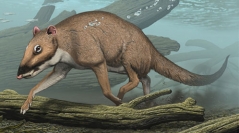

 Comptes Rendus Palevol
8 (2-3) - Pages 295-309
Comptes Rendus Palevol
8 (2-3) - Pages 295-309Cetaceans are the most highly modified mammals. They originate among terrestrial ariodactyles during the Early Eocene. The oldest known cetacean is Pakicetus, a terrestrial and cursorial taxon of the Early Eocene (50 Ma), which entered the water in search for food or, possibly, to protect its skin from the sun. A few million years later, Ambulocetus is an amphibious cetacean capable of moving on land but also an agile swimmer using its hind limbs for propulsion. Ambulocetus was a formidable predator with powerful teeth. The nares of Pakicetus and Ambulocetus were anteriorly placed, at the apex of the snout. During the Late Eocene, there appeared the first strictly aquatic cetaceans, the Basilosauridae. Their hind limbs are totally atrophied and are not functional. The nares are on the dorsal face of the rostrum on the anterior third of the skull. From that time, the way toward modern cetaceans was opened; the oldest mysticetes are from the Latest Eocene and the oldest odontocetes from the Early Oligocene.
Cetaceans, Origin, Evolutionary history, Adaptations, Swimming